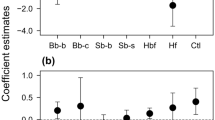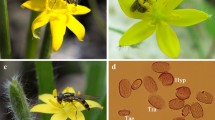Abstract
Plant-pollinator interactions have usually been researched in flowers that have fully opened. However, some pollinators can visit flowers before full opening and contribute to fruit and seed sets. In this paper, we researched the pollination biology of flowers just starting to open in four field experiments. We observed the insect visitors to Lycoris sanguinea var. sanguinea for 3 years at five sites. These observations revealed that only small bees, Lasioglossum japonicum, often entered through tiny spaces between the tepals of ‘breaking buds’ (i.e. partially opened flowers) and collected pollen. We hypothesized that they can pollinate this species at the breaking-bud stage, when the stigma is located near the anthers. To measure the pollination effect of small bees at the breaking-bud stage, we bagged several breaking buds after small bees had visited them and examined whether these buds were pollinated. In bagging experiments, 30 % of the breaking buds set fruit and seeds. Fruit-set ratios of the breaking buds did not differ significantly from those of the fully opened flowers, which had been visited by several insect species. We also counted the pollen grain numbers on the body of L. japonicum and on the anthers of randomly-selected and manipulated flowers. These experiments revealed that all of the captured bees had some pollen of target plants and that L. japonicum collected most of the pollen grains at the breaking-bud stage. Our results showed that the new pollination process, breaking-bud pollination, happened in breaking buds by L. japonicum, although there is no evidence to reveal that this is the most effective pollination method for L. sanguinea var. sanguinea. In principle, this new pollination process can occur in other flowering plants and our results are a major contribution to studies of plant-pollinator interactions.



Similar content being viewed by others
References
Agrawal AA (2011) Current trends in the evolutionary ecology of plant defence. Func Ecol 25:420–432. doi:10.1111/j.1365-2435.2010.01796.x
Arroyo J, Dafni A (1995) Variations in habitat, season, flower traits and pollinators in dimorphic Narcissus tazetta L. (Amaryllidaceae) in Israel. New Phytol 129:135–145. doi:10.1111/j.1469-8137.1995.tb03017.x
Boyd RS, Teem A, Wall MA (2011) Floral biology of an Alabama population of the federally endangered plant, Xyris tennesseensis Kral (Xyridaceae). Castanea 76:255–265
Culley TM, Klooster MR (2007) The cleistogamous breeding system: a review of its frequency, evolution, and ecology in angiosperms. Bot Rev 73:1–30. doi:10.1663/0006-8101(2007)73[1:TCBSAR]2.0.CO;2
Darwin C (1877) The different forms of flowers on plants of the same species. John Murray, London
Faegri K, van der Pijl L (1979) The principles of pollination ecology. Pergamon Press, Oxford
Fenster CB, Armbruster WS, Wilson P, Dudash MR, Thomson JD (2004) Pollination syndromes and floral specialization. Annu Rev Ecol Evol Syst 35:375–403. doi:10.1146/annurev.ecolsys.34.011802.132347
Fontaine C, Dajoz I, Meriguet J, Loreau M (2006) Functional diversity of plant-pollinator interaction webs enhances the persistence of plant communities. PLoS Biol 4:129–135. doi:10.1371/journal.pbio.0040001
Galen C, Stanton ML (1989) Bumble bee pollination and floral morphology: factors influencing pollen dispersal in the alpine sky pilot, Polemonium viscosum (Polemoniaceae). Am J Bot 76:419–426. doi:10.2307/2444612
Gathmann A, Tscharntke T (2002) Foraging ranges of solitary bees. J Anim Ecol 71:757–764. doi:10.1046/j.1365-2656.2002.00641.x
Greenleaf SS, Williams NM, Winfree R, Kremen C (2007) Bee foraging ranges and their relationship to body size. Oecologia 153:589–596. doi:10.1007/s00442-007-0752-9
Harder LD (1990) Pollen removal by bumble bees and its implications for pollen dispersal. Ecology 71:1110–1125. doi:10.2307/1937379
Harder LD, Thomson JD (1989) Evolutionary options for maximizing pollen dispersal of animal-pollinated plants. Am Nat 133:323–344. doi:10.1086/284922
Hermann K, Klahre U, Moser M, Sheehan H, Mandel T, Kuhlemeier C (2013) Tight genetic linkage of prezygotic barrier loci creates a multifunctional speciation island in petunia. Current Biol 23:873–877. doi:10.1016/j.cub.2013.03.069
Hsu PS, Kurita S, Yu ZZ, Lin JZ (1994) Synopsis of the genus Lycoris (Amaryllidaceae). SIDA 16:301–331
Johnson SD, Steiner KE (2000) Generalization vs. specialization in plant pollination systems. Trends Ecol Evol 15:140–143. doi:10.1016/S0169-5347(99)01811-X
Kawano S (2009) Life-history monographs of Japanese plants. 13: Lycoris sanguinea Maxim. (Amaryllidaceae). Plant Spec Biol 24:139–144. doi:10.1111/j.1442-1984.2009.00249.x
Kettle CJ, Maycock CR, Ghazoul J, Hollingsworth PM, Khoo E, Sukri RSH, Burslem DFRP (2010) Ecological implications of a flower size/number trade-off in tropical forest trees. PLoS One 6:e16111. doi:10.1371/journal.pone.0016111
Lord EM (1981) Cleistogamy: a tool for the study of floral morphogenesis, function and evolution. Bot Rev 47:421–449. doi:10.1007/BF02860538
Ma B, Tarumoto I, Morikawa T (2000) Cytological studies on selfed plants and interspecific crosses produced in four species of genus Lycoris (Amaryllidaceae). Sci Rep Coll Agric Osaka Pref Univ 52:13–18
Ma B, Tarumoto I, Nakamura N, Kunitake H (2001) Production of interspecific hybrids between Lycoris incarnata and four other Lycoris species through embryo culture. J Japan Soc Hortic Sci 70:697–703
Nasrallah ME (1974) Genetic control of quantitative variation in self-incompatibility proteins detected by immunodiffusion. Genetics 76:45–50
Ollerton J, Alarcón R, Waser NW, Price MV, Watts S, Cranmer L, Hingston A, Peter CI, Rottenberry J (2009) A global test of the pollination syndrome hypothesis. Annal Bot 103:1471–1480. doi:10.1093/aob/mcp031
Proctor M, Yeo P, Lack A (1996) The natural history of pollination. Harper Collins, London
Redbo-Torstensson P, Berg H (1995) Seasonal cleistogamy: a conditional strategy to provide reproductive assurance. Plant Biol 44:247–256. doi:10.1111/j.1438-8677.1995.tb00783.x
Rosas-Guerrero V, Aguilar R, Martén-Rodríguez S, Ashworth L, Lopezaraiza-Mikel M, Bastida JM, Quesada M (2014) A quantitative review of pollination syndromes: do floral traits predict effective pollinators? Ecol Lett 17:388–400. doi:10.1111/ele.12224
Roulston TH, Cane JH (2000) Pollen nutritional content and digestibility for animals. Plant Syst Evol 222:187–209. doi:10.1007/BF00984102
Tadauchi O, Dawut A, Inoue H (2001) On image database file HANABACHI based on the Japanese bees. ESAKIA 41:149–154
Thorp RW (1979) Structural, behavioral, and physiological adaptations of bees (Apoidea) for collecting pollen. Annal Miss Bot Gar 66:788–812
Thorp RW (2000) The collection of pollen by bees. Plant Syst Evol 222:211–223. doi:10.1007/978-3-7091-6306-1_11
Wall MA, Teem AP, Boyd RS (2002) Floral manipulation by Lasioglossum zephyrum (Hymenoptera: Halictidae) ensures first access to floral rewards by initiating premature anthesis of Xyris tennesseensis (Xyridaceae) flowers. Fla Entomol 85:290–291
Waller DM (1984) Differences in fitness between seedlings derived from cleistogamous and chasmogamous flowers in Impatiens capensis. Evolution 38:427–440
Wang R, Xu S, Jiang Y, Jiang J, Li X, Liang L, He J, Peng F, Xia B (2013) De novo sequence assembly and characterization of Lycoris aurea transcriptome using GS FLX Titanium platform of 454 Pyrosequencing. PLoS One 8:e60449. doi:10.1371/journal.pone.0060449
Waser NM, Chittka L, Price MV, Williams NM, Ollerton J (1996) Generalization in pollination systems, and why it matters. Ecology 77:1043–1060
Willson MF, Traveset A (2000) The ecology of seed dispersal. In: Fenner M (ed) Seeds: the ecology of regeneration in plant communities. CAB Int, Wallingford, pp 85–110
Wright KM, Bomblies K (2013) Evolutionary genetics: inheritance of a complex pollination syndrome. Current Biol 23:R525–R527. doi:10.1016/j.cub.2013.04.069
Zurbuchen A, Landert L, Klaiber J, Müller A, Hein S, Dorn S (2010) Maximum foraging ranges in solitary bees: only few individuals have the capability to cover long distances. Biol Cons 143:669–676. doi:10.1016/j.biocon.2009.12.003
Acknowledgments
The authors thank O. Tadauchi, Kyushu University, for insect identification. We also thank Y. Watano, Chiba University, T. Takano, The University of Tokyo, L. K. Faulks, Uppsala University, and two anonymous reviewers for their helpful comments on the manuscript. This research was partly supported by Grant-in-Aid for JSPS Fellows (26.11613).
Author information
Authors and Affiliations
Corresponding author
Rights and permissions
About this article
Cite this article
Yamaji, F., Ohsawa, T.A. Breaking-bud pollination: a new pollination process in partially opened flowers by small bees. J Plant Res 128, 803–811 (2015). https://doi.org/10.1007/s10265-015-0741-8
Received:
Accepted:
Published:
Issue Date:
DOI: https://doi.org/10.1007/s10265-015-0741-8




